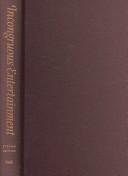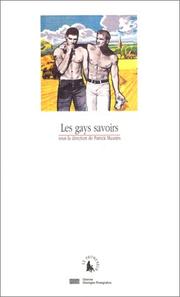| Listing 1 - 7 of 7 |
Sort by
|

ISBN: 0822335956 0822335573 0822387077 1283022001 9786613022004 Year: 2005 Publisher: Durham : Duke University Press,
Abstract | Keywords | Export | Availability | Bookmark
 Loading...
Loading...Choose an application
- Reference Manager
- EndNote
- RefWorks (Direct export to RefWorks)
Musical films --- Homosexuality and motion pictures --- Camp (Style) --- Films musicaux --- Homosexualité et cinéma --- History and criticism --- Histoire et critique --- Metro-Goldwyn-Mayer.
Book
ISBN: 9780520971295 Year: 2023 Publisher: Oakland, California : University of California Press,
Abstract | Keywords | Export | Availability | Bookmark
 Loading...
Loading...Choose an application
- Reference Manager
- EndNote
- RefWorks (Direct export to RefWorks)
"Gathering an unexplored archive of fan-made scrapbooks, letters, diaries, and photographs, A Queer Way of Feeling explores how, in the 1910s, girls coming of age in the United States used cinema to forge a foundational language of female nonconformity, intimacy, and kinship. Pasting cross-dressed photos on personal scrapbooks and making love to movie actresses in epistolary writing, adolescent girls from all walks of life stitched together established homoerotic conventions with an emergent syntax of film stardom to make sense of mental states, actions, and proclivities self-described as "queer" or "different from the norm." Material testimonies of a forgotten audience, these autobiographical artifacts show how early movie-loving girls engendered terminologies, communities, and creative practices that would become cornerstones of media fan reception and queer belonging"--
Homosexuality and motion pictures. --- Lesbianism --- Motion pictures and women. --- Fans (Persons) --- Young women --- Femmes --- Cinéma et femmes. --- Fans --- Homosexualité et cinéma --- Au cinéma.
Book
ISBN: 9781433107078 1433107074 Year: 2009 Publisher: New York, N.Y. Lang
Abstract | Keywords | Export | Availability | Bookmark
 Loading...
Loading...Choose an application
- Reference Manager
- EndNote
- RefWorks (Direct export to RefWorks)
Film --- France --- Motion pictures --- Motion picture audiences --- Homosexuality and motion pictures --- Homosexuality in motion pictures. --- Cinéma --- Homosexualité et cinéma --- Homosexualité au cinéma --- History --- Histoire --- Publics --- Cinéma --- Homosexualité et cinéma --- Homosexualité au cinéma

ISBN: 2070752127 2858509719 Year: 1998 Publisher: Paris Gallimard
Abstract | Keywords | Export | Availability | Bookmark
 Loading...
Loading...Choose an application
- Reference Manager
- EndNote
- RefWorks (Direct export to RefWorks)
Fonds Suzan Daniel (FSD)
Gay men --- Homosexuality and literature --- Homosexuality and motion pictures --- Homosexuels masculins --- Homosexualité et littérature --- Homosexualité et cinéma --- Social life and customs --- Congresses. --- Moeurs et coutumes --- Congrès --- Homosexualité et littérature --- Homosexualité et cinéma --- Congrès
Book
ISBN: 9780197604045 9780197604038 Year: 2022 Publisher: New York : Oxford University Press,
Abstract | Keywords | Export | Availability | Bookmark
 Loading...
Loading...Choose an application
- Reference Manager
- EndNote
- RefWorks (Direct export to RefWorks)
"The Queer Biopic returns to the historical moment of the AIDS crisis and the emergence of New Queer Cinema to investigate the phenomena of queer biopic films produced during the late 1980s-early 1990s. More specifically, the book asks why queer filmmakers repeatedly produced biographical films of queer individuals living and dead throughout the years surrounding the AIDS crisis. While film critics and historian typically treat the biopic as a conservative, if not cliché, genre, queer filmmakers have frequently used the biopic to tell stories of queer lives. This project pays particular attention to the genre's queer resonances, opening up the biopic's historical connections to projects of education, public health, and social hygiene, along with the production of a shared history and national identity. Queer filmmakers' engagement with the biopic evokes the genre's history of building life through the portrayal of lives worthy of admiration and emulation, but it also points to another biopic history, that of representing lives damaged. By portraying lives damaged by inconceivable loss, queer filmmakers challenge the illusion of a coherent self presumably reinforced by the biopic genre and in doing so, their films open up the potential for new means of connection and relationality. The book features fresh readings of the cinema of Derek Jarman, John Greyson, Todd Haynes, Barbara Hammer, and Tom Kalin. By calling for a reappraisal of the queer biopic, the book also calls for a reappraisal of New Queer Cinema's legacy and its influence of contemporary queer film"--
Book
ISBN: 9781350187658 9781350188402 Year: 2021 Publisher: New York : Bloomsbury Academic,
Abstract | Keywords | Export | Availability | Bookmark
 Loading...
Loading...Choose an application
- Reference Manager
- EndNote
- RefWorks (Direct export to RefWorks)
"In Screening Queer Memory, Anamarija Horvat examines how LGBTQ history has been represented on-screen, and interrogates the specificity of queer memory. She poses several questions: How are the pasts of LGBTQ people and communities visualised and commemorated on screen? How do these representations comment on the influence of film and television on the construction of queer memory? How do they present the passage of memory from one generation of LGBTQ people to another? Finally, which narratives of the queer past, particularly of the activist past, are being commemorated, and which obscured? Horvat exemplifies how contemporary British and American cinema and television have commented on the specificity of queer memory - how they have reflected aspects of its construction, as well as participated in its creation. In doing so, she adds to an under-examined area of queer film and television research which has privileged concepts of nostalgia, history, temporality and the archive over memory. Films and television shows explored include Cheryl Dunye's The Watermelon Woman (1996), Todd Haynes' Velvet Goldmine (1998), Jill Soloway's Transparent (2014), Matthew Warchus' Pride (2014) and Tom Rob Smith's London Spy (2015)"--
Homosexuality in motion pictures. --- Homosexuality on television. --- Queer theory. --- Sex role in motion pictures. --- Sex role on television. --- Sexual minorities in motion pictures. --- Sexual minorities on television. --- Transgender people in motion pictures. --- Gender identity on television. --- Homosexualité et cinéma. --- Homosexualité et cinéma.

ISBN: 0742519716 0742519724 Year: 2006 Volume: *2 Publisher: Lanham [etc.] Rowman & Littlefield
Abstract | Keywords | Export | Availability | Bookmark
 Loading...
Loading...Choose an application
- Reference Manager
- EndNote
- RefWorks (Direct export to RefWorks)
Sociology of the family. Sociology of sexuality --- Film --- United States --- Gays in motion pictures. --- Homosexuality and motion pictures. --- Homosexuality in motion pictures. --- Motion pictures --- Gays in motion pictures --- Homoseksualiteit en de film --- Homoseksualiteit in de film --- Homoseksuelen in de film --- Homosexuality and motion pictures --- Homosexuality in motion pictures --- Homosexualité dans le cinéma --- Homosexualité et le cinéma --- Homosexuels dans le cinéma --- Homosexualité au cinéma --- Homosexuels au cinéma --- Homosexualité et cinéma --- Cinéma --- United States of America --- Gay people in motion pictures.
| Listing 1 - 7 of 7 |
Sort by
|

 Search
Search Feedback
Feedback About UniCat
About UniCat  Help
Help News
News